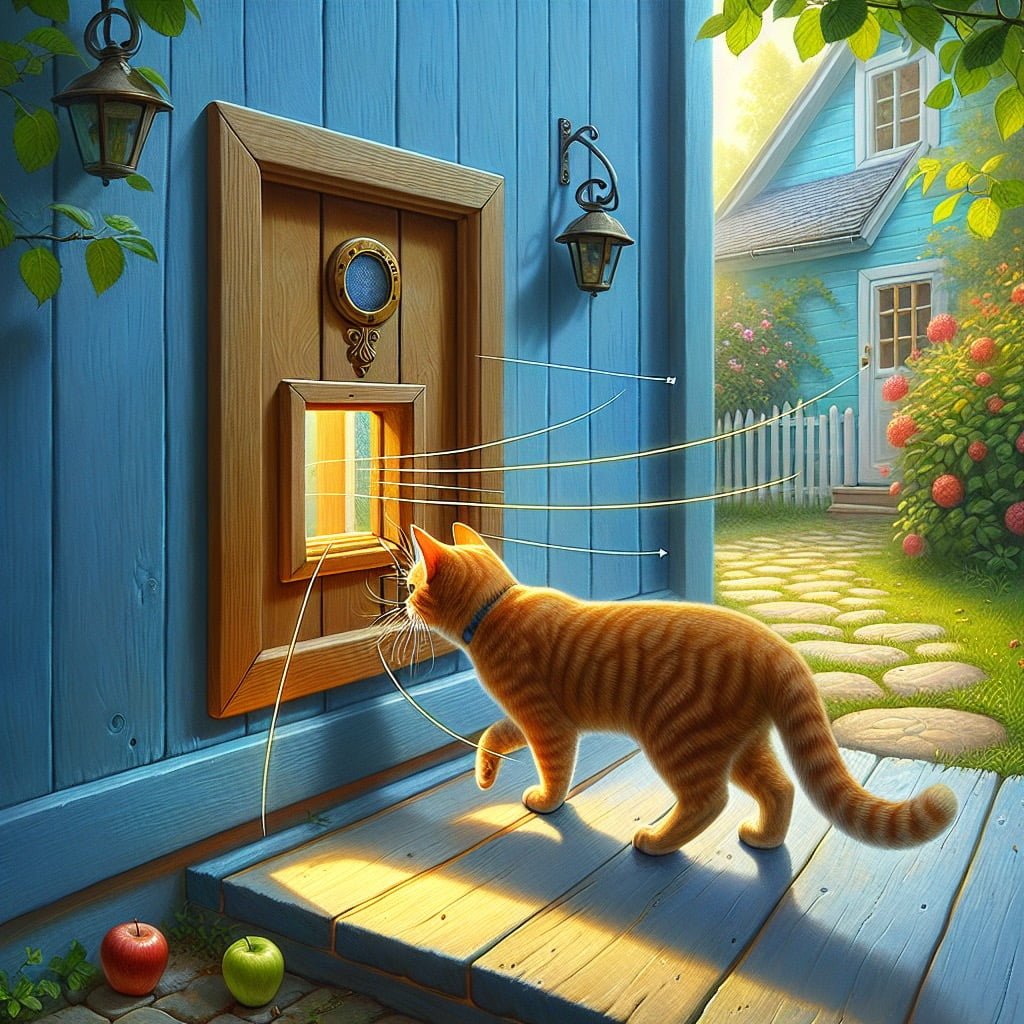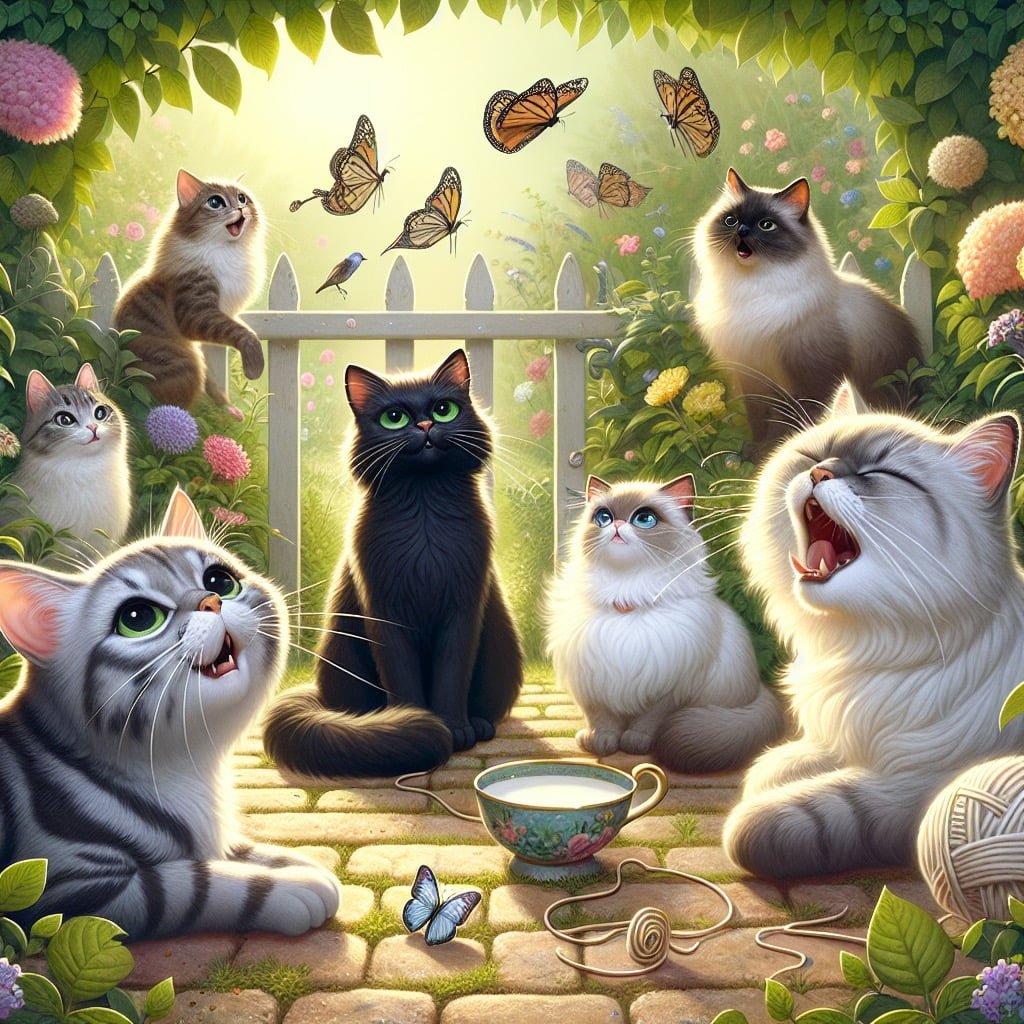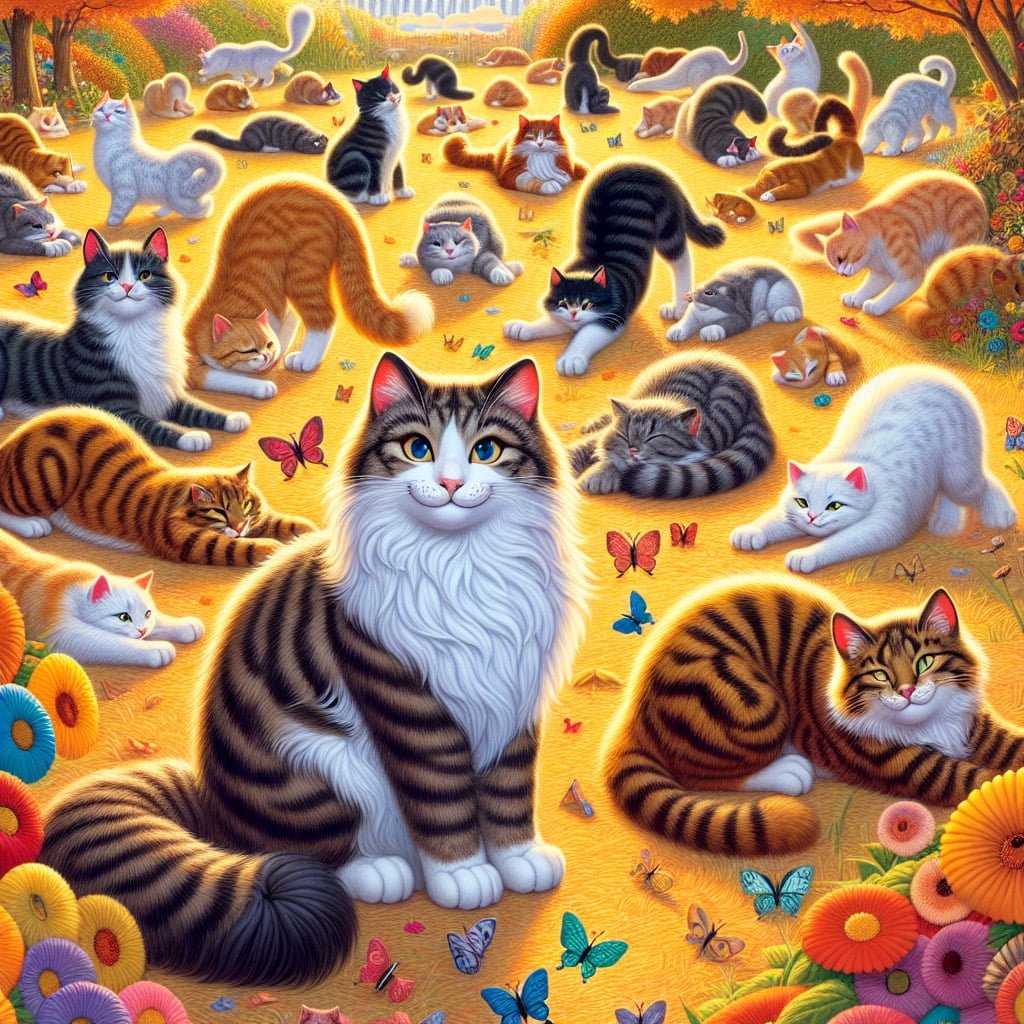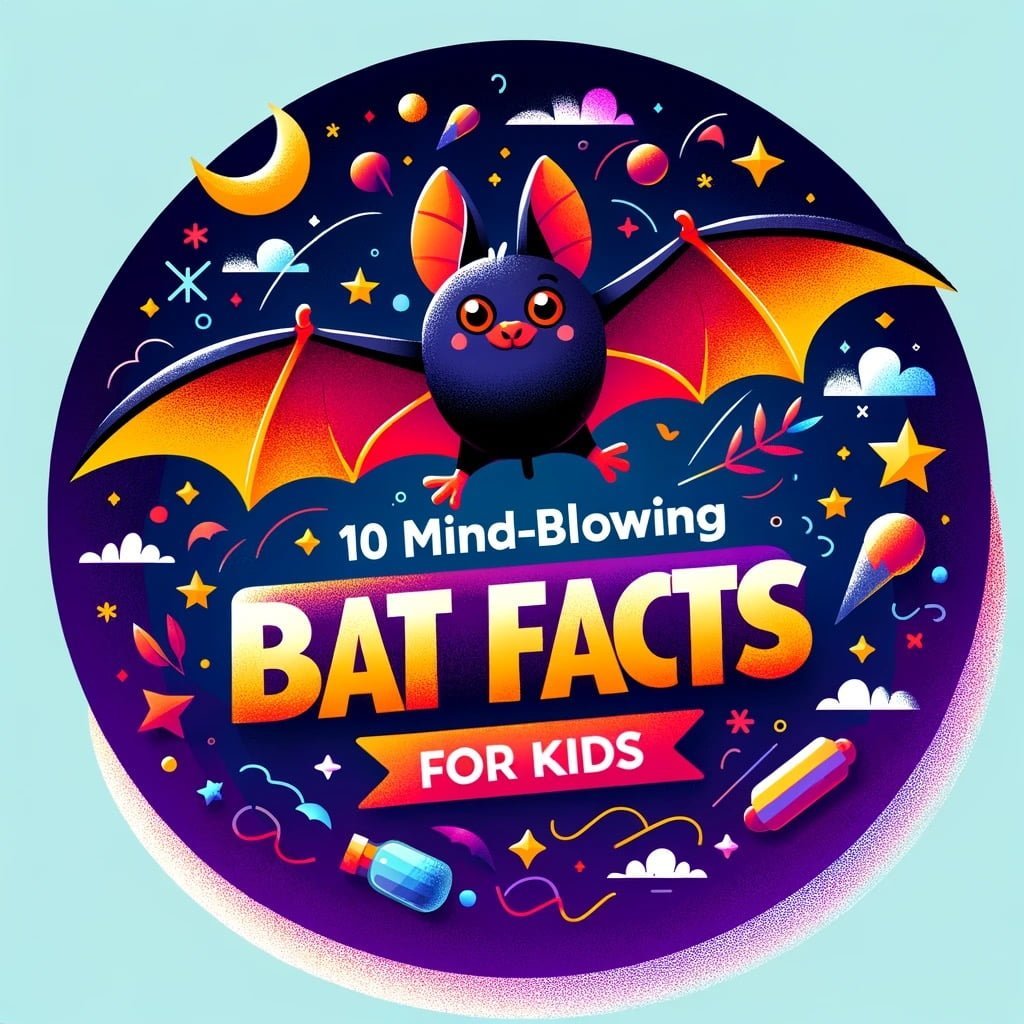Welcome to our blog post on Cat Facts For Kids! Cats are truly fascinating creatures with unique behaviors and characteristics that captivate both young and old alike. From their whiskers for navigation to their ability to make over 100 different sounds, there is so much to learn and explore about our beloved feline friends. Join us as we delve into the world of fun facts about cats, offering insights that will deepen your understanding and appreciation of these incredible animals. Whether you’re a cat enthusiast or simply curious about the secrets of the animal kingdom, this blog post is sure to inspire wonder and foster a love for our furry companions. Let’s embark on this exciting journey together as we uncover the amazing world of Cat Facts For Kids!
Cat Facts For Kids
1. Cats Have Whiskers for Navigation

For younger kids: Cats use their whiskers to figure out where they can fit.
For older kids: Cats possess highly sensitive whiskers, which they use to detect changes in their surroundings and measure the width of gaps to navigate through tight spaces.
Detailed explanation:Cats have whiskers for navigation. These sensitive hairs, also known as vibrissae, are not just there for decoration. They serve an important purpose in helping cats navigate their surroundings and detect potential dangers.
Each whisker is connected to a cluster of nerves at its base, making them incredibly sensitive to changes in the environment. When a cat brushes up against an object, the whiskers send signals to the cat’s brain, providing information about the size, shape, and texture of the object. This helps cats determine whether they can fit through a narrow space or if they need to find an alternate route.
Cat Facts For Kids also play a crucial role in helping cats gauge distances. By sensing the airflow around objects, whiskers can help cats judge the distance between themselves and obstacles, allowing them to navigate through tight spaces with ease. This is especially important for cats who may be hunting prey or trying to escape from predators.
In addition to aiding in navigation, whiskers can also serve as a form of communication for cats. When a cat is feeling threatened or aggressive, it may bristle its whiskers, making itself appear larger and more intimidating. On the other hand, when a cat is feeling relaxed and content, its whiskers may be more relaxed and laid back.
Overall, whiskers are an essential tool for cats, helping them navigate their surroundings, communicate with others, and stay safe in their environment.
Cat Facts For Kids
2. Cats Can Make Over 100 Sounds

For younger kids: Cats can make a lot of different noises to talk to us and each other.
For older kids: Unlike dogs that have a limited vocal range, cats can produce more than 100 vocal sounds to communicate with humans and other felines.
Detailed explanation:Cats are fascinating creatures that have the ability to make over 100 different sounds, making them one of the most vocal animals in the animal kingdom. These sounds range from meows and purrs to hisses and growls, each serving a different purpose in feline communication.
One of the most common sounds that cats make is the meow. Cats use meows to communicate with their human companions, often varying the pitch and tone of the meow to convey different meanings. For example, a short, high-pitched meow may indicate that a cat is happy or excited, while a low, drawn-out meow may signal that a cat is feeling anxious or in distress.
Purring is another common sound that cats make, and it is often associated with contentment and relaxation. Cats will often purr when they are being petted or when they are feeling comfortable and safe. However, cats may also purr when they are injured or stressed, as purring has been shown to have healing properties and can help to calm a cat down in times of distress.
In addition to meows and purrs, cats also make a variety of other sounds, such as hisses, growls, chirps, and trills. These sounds are used in different situations to communicate different emotions, such as fear, aggression, or excitement. By paying attention to the sounds that their cats make, pet owners can better understand their feline companions and provide them with the care and attention that they need.
In conclusion, cats are incredibly vocal animals that have the ability to make over 100 different sounds. By learning more about cat communication and the meanings behind their various sounds, pet owners can deepen their bond with their feline friends and ensure that they are meeting their needs. Cat Facts For Kids are a great way to learn more about these fascinating creatures and how to care for them properly.
Cat Facts For Kids
3. A Group of Cats is Called a Clowder

For younger kids: A big group of cats has its own special name – a clowder!
For older kids: When you see a group of cats together, you’re looking at what’s known as a ‘clowder’. This term is one of many collective nouns for animals.
Detailed explanation:If you’re a fan of felines, you may already know that a group of cats is called a clowder. This term may not be as commonly known as a “pack” of wolves or a “flock” of birds, but it is the official collective noun for our beloved domesticated companions.
Cat Facts For Kids can be a fun way to educate children about these fascinating animals. Not only can they learn about the different breeds, behaviors, and care requirements of cats, but they can also delve into interesting tidbits like the term “clowder.” Encouraging children to explore the world of cats can foster a love and appreciation for these independent and mysterious creatures.
In the wild, feral cats often form colonies or communities, but in a household setting, a clowder may consist of multiple cats living together in harmony. Observing the dynamics within a clowder can provide insights into cat social structures and hierarchies. Each cat may have its own unique personality, but they can also develop close bonds with their fellow feline companions.
Learning about Cat Facts For Kids can also help children understand the importance of responsible pet ownership. From providing proper nutrition and veterinary care to creating a stimulating environment for play and exercise, caring for cats requires dedication and commitment. By instilling these values early on, children can grow up to be compassionate and empathetic individuals who respect and cherish their animal companions.
Cat Facts For Kids
4. Cats Can Sleep for Up to 16 Hours

For younger kids: Cats love to sleep a lot during the day and night.
For older kids: Cats are true sleep experts—on average, they can snooze for up to 16 hours a day to conserve energy for hunting and playing.
Detailed explanation:Cats are known for their ability to sleep for long periods of time, often up to 16 hours a day. This behavior may seem excessive to some, but it is actually quite normal for our feline friends. In fact, cats are crepuscular animals, which means they are most active during dawn and dusk. This is why you may notice your cat sleeping for most of the day and night, only to suddenly become lively and energetic during these particular times.
One of the reasons why cats sleep so much is because of their natural hunting instincts. In the wild, cats would spend much of their time stalking and hunting prey. This requires a lot of energy, so they need to conserve their strength by sleeping for long periods of time. Even though our domesticated cats may not need to hunt for their food, this behavior is still deeply ingrained in their DNA.
Another factor that contributes to cats’ long periods of sleep is their unique sleep cycle. Cats are usually in a light sleep state, ready to wake up at a moment’s notice to defend themselves or hunt. This light sleep allows them to be alert and responsive, even while resting.
In conclusion, it is completely normal for cats to sleep for up to 16 hours a day. This behavior is essential for their overall well-being and is a natural part of their biology. So next time you see your feline friend curled up in a deep slumber, remember that they are simply following their instincts. And if you want to learn more interesting Cat Facts For Kids, keep exploring the fascinating world of feline behavior.
Cat Facts For Kids
5. The Egyptian Mau is a Naturally Spotted Breed

For younger kids: The Egyptian Mau cat has natural spots that look really cool!
For older kids: The Egyptian Mau is one among a few naturally spotted breeds of domestic cats; these spots are not created by selective breeding but are a part of its wild heritage.
Detailed explanation:The Egyptian Mau is a naturally spotted breed of domestic cat that has a distinct appearance and a rich history. These cats are known for their unique coat pattern, which features spots in various shades of brown and black. The spots are randomly distributed across their short, dense fur, giving them a wild and exotic look.
One of the most interesting Cat Facts For Kids about the Egyptian Mau is that their spots are a result of a natural genetic mutation. Unlike other spotted cat breeds, such as the Bengal cat, which have been selectively bred for their spots, the Egyptian Mau’s spotting pattern is a product of natural selection. This means that these cats have maintained their unique appearance through generations without human intervention.
The Egyptian Mau is also known for its striking green eyes, which are large and almond-shaped. This breed is medium in size, with a muscular build and a graceful, athletic appearance. They are known for their agility and speed, making them skilled hunters and excellent climbers.
In addition to their physical characteristics, the Egyptian Mau is also known for their playful and affectionate nature. They are social cats that enjoy interacting with humans and other animals, making them great companions for families with children.
Overall, the Egyptian Mau is a fascinating breed with a rich history and unique characteristics. Their naturally spotted coat, striking green eyes, and friendly personality make them a popular choice for cat lovers around the world.
Cat Facts For Kids
6. Cats Have a Unique “Righting Reflex”

For younger kids: Cats can twist in the air to land on their feet!
For older kids: Cats possess a fascinating ability called the “righting reflex”, which allows them to orient themselves as they fall and usually land on their feet from high places.
Detailed explanation:Cats Have a Unique “Righting Reflex” is one of the most fascinating Cat Facts For Kids. This reflex is an innate ability that all cats possess, allowing them to twist their bodies in mid-air to land on their feet when falling. This incredible skill is a result of their flexible spine and incredible agility.
When a cat falls from a height, it instinctively rotates its body so that its feet are facing downwards. This is made possible by a combination of their vestibular system, which helps them maintain balance and orientation in space, and their highly flexible backbone, which allows them to twist and turn their body with ease.
Not only do cats have the ability to quickly reorient themselves mid-fall, but they also have an impressive sense of timing. This allows them to make split-second calculations about the best angle and position to land safely on their feet. Their keen reflexes and lightning-fast reactions make them some of the most agile and acrobatic creatures in the animal kingdom.
It’s important to note that while cats have a remarkable “righting reflex,” they are not invincible to falls. Cats can still sustain injuries from falls, especially from great heights. Even with their incredible agility, it’s best to keep windows and balconies closed to prevent accidental falls and ensure the safety of our feline friends. Nevertheless, the “righting reflex” is just one example of the many amazing adaptations that make cats such fascinating creatures.
Cat Facts For Kids
7. The World’s Oldest Cat Lived to 38 Years

For younger kids: Some cats can live really long—like almost as old as some grandmas and grandpas!
For older kids: The oldest recorded cat, named Creme Puff, lived an astonishing 38 years and 3 days, which is almost double the average lifespan of domestic cats.
Detailed explanation:One of the most fascinating Cat Facts For Kids is the story of Creme Puff, the world’s oldest cat on record who lived to be an incredible 38 years old. Creme Puff’s longevity is truly remarkable, as the average lifespan of a domestic cat is typically around 12-15 years. So how did Creme Puff manage to live more than double the average lifespan of a cat?
There are several factors that likely contributed to Creme Puff’s impressive lifespan. First and foremost, she was fortunate to have been well taken care of by her owners. Proper nutrition, regular vet check-ups, and a loving home environment can all play a significant role in extending a cat’s lifespan. Creme Puff’s owners made sure she received the best care possible, which likely helped her live a longer and healthier life.
Additionally, genetics may have also played a role in Creme Puff’s longevity. Some cats are simply blessed with good genes that allow them to live longer than others. It’s possible that Creme Puff had a genetic predisposition to longevity, which helped her reach such an advanced age.
Overall, Creme Puff’s story serves as a shining example of the potential longevity that cats can achieve with proper care and genetics. While not every cat will live to be 38 years old, by providing a loving home and quality care, cat owners can help ensure that their feline companions live long, happy, and healthy lives.
Cat Facts For Kids
8. Cats Can Hear Ultrasonic Noises

For younger kids: Cats have super ears and can hear sounds that even dogs can’t!
For older kids: A cat’s ears are incredibly powerful, allowing them to hear ultrasonic noises. This ability is essential for hunting, as it lets them hear the high-pitched sounds of rodents.
Detailed explanation:Cats are truly remarkable animals with a variety of senses that are far superior to humans. One particularly fascinating fact about cats is their ability to hear ultrasonic noises. This means that they can detect sounds at a much higher frequency than what the human ear is capable of hearing.
Cats have highly developed auditory senses, with the ability to hear both higher and lower frequencies than humans. This is due to special structures in their ears, including a complex system of muscles that allow them to precisely control the movement of their earflaps in order to better capture sound. In fact, cats can rotate their ears independently in order to pinpoint the source of a sound, giving them a distinct advantage in hunting and detecting predators.
The ability of cats to hear ultrasonic noises has been studied extensively by scientists, who have found that they are particularly sensitive to frequencies in the range of 45,000 to 64,000 Hz. This makes cats capable of hearing sounds that are completely imperceptible to humans, such as those made by rodents and insects. In fact, many electronic devices designed to deter pests emit ultrasonic frequencies that are only audible to cats and other animals with similar hearing abilities.
In conclusion, the fact that cats can hear ultrasonic noises is just one example of their incredible sensory abilities. As any cat Facts For Kids will tell you, these animals are truly masters of their environment, able to detect and respond to stimuli that are completely beyond human perception.
Cat Facts For Kids
9. A Cat’s Nose is as Unique as a Human’s Fingerprint

For younger kids: Every cat has a different pattern on its nose, just like we have different fingerprints.
For older kids: Similar to how every person’s fingerprint is different, each cat has a unique nose print, with a distinct pattern of ridges and bumps.
Detailed explanation:Cat Facts For Kids can be fascinating, especially when it comes to the unique features of our feline friends. One particularly interesting fact is that a cat’s nose is as unique as a human’s fingerprint. Just like how no two human fingerprints are the same, each cat has a completely individual nose print that sets them apart from all other cats.
Cat noses are covered in tiny ridges and bumps, similar to the fingerprints of humans. These patterns are formed while the cat is still in the womb and are believed to serve as a form of identification. This can be especially helpful in scenarios where cats may need to be identified, such as in shelters or veterinary offices.
While we may not be able to easily see the intricate details of a cat’s nose like we can with a fingerprint, researchers have found ways to study and analyze these unique patterns. By using advanced technology, such as infrared scans or high-resolution cameras, experts are able to capture and compare the individual characteristics of cat noses.
Understanding that a cat’s nose print is unique highlights the incredible diversity and complexity of the animal world. It also serves as a reminder of the importance of paying attention to the finer details of our pets, as they each have their own special traits that make them truly one-of-a-kind. So, next time you snuggle up with your cat, take a moment to appreciate the uniqueness of their nose print – it’s just one more reason to love these amazing animals.
Cat Facts For Kids
10. Cats Can’t Taste Sweetness

For younger kids: Cats are not able to taste sweet things like candy.
For older kids: Cats lack the taste receptors for sweetness, which may be a result of their carnivorous ancestry where a taste for sugars wasn’t necessary.
Detailed explanation:Cat Facts For Kids: Cats Can’t Taste Sweetness
One interesting fact about cats is that they lack the ability to taste sweetness. Cats have a limited number of taste receptors on their tongues, compared to humans and some other animals. These taste receptors, known as taste buds, are responsible for detecting different flavors in food. In humans, there are taste buds sensitive to sweet, salty, sour, bitter, and umami (savory) flavors. However, cats do not have the sweet taste receptors that humans possess.
This lack of ability to taste sweetness in cats is thought to be due to their evolutionary history as obligate carnivores. Cats are natural hunters and their diet primarily consists of meat. They do not have a biological need for sweet foods like fruits or sugary treats. In fact, their taste preferences are geared towards detecting and enjoying the savory flavors of meat.
It is important for cat owners to be aware of this fact when considering what foods to offer their feline companions. Cats might show interest in foods that are sweet to humans, but it’s important to remember that they are not actually able to taste the sweetness. Feeding cats sugary foods can also be harmful to their health, leading to conditions like obesity and diabetes.
In conclusion, understanding the unique taste preferences of cats, including the fact that they cannot taste sweetness, can help cat owners make informed decisions about their feline friends’ diet and overall health.
Did You Know?
Cats sometimes bring their owners “gifts” in the form of bugs or mice because they think of their humans as family and want to share their hunting success.
‘Summary of Cat Facts For Kids’
Cats have long been admired for their mysterious and playful nature, captivating the hearts of millions around the world. But did you know that there is so much more to these fascinating felines than meets the eye? Exploring fun and interesting facts about cats can not only provide valuable insights into their behavior and characteristics but also help children develop empathy and responsibility towards animals.
By delving into the world of cat facts for kids, we can uncover the unique ways in which cats communicate, their keen senses that make them excellent hunters and explorers, and the long history of companionship they share with humans. Understanding these fun facts can not only deepen our connection with our furry friends but also inspire a sense of wonder and curiosity about the natural world, fostering a lifelong love of learning and discovery.
So, if you’re looking to expand your knowledge about these beloved and captivating creatures, reading more about cat facts for kids is definitely worth the journey. Join us as we unravel the amazing secrets and stories that make cats such special animals, and embark on an adventure of exploration and discovery with our feline friends.
Sources and additional information for Cat Facts For Kids
WikipediaBritannicaSan Diego Zoo KidsThe Smithsonian InstitutionDK Find Out!Australian MuseumWorld Wildlife FundThe Nature ConservancyAnimal PlanetMonterey Bay AquariumPBS NatureSmithsonian’s National Zoo & Conservation Biology InstituteWorld Wildlife FundAnimal Diversity Web (University of Michigan)IUCN Red List of Threatened SpeciesThe Cornell Lab of Ornithology – All About BirdsNational Audubon SocietyEncyclopedia of LifeSeaWorld Parks & EntertainmentAustralian Museum – AnimalsEncyclopedia of Life




